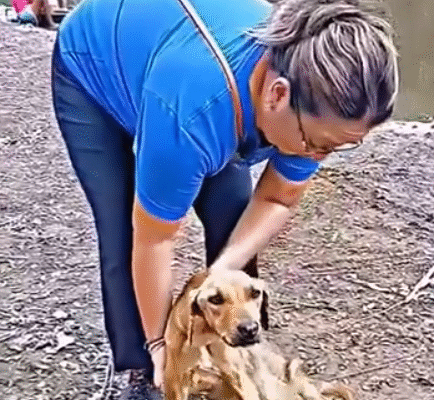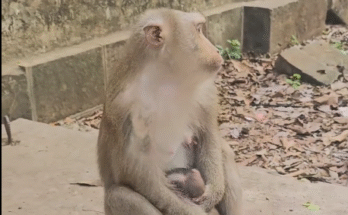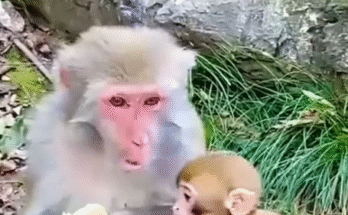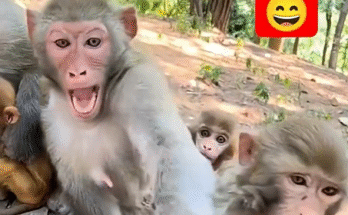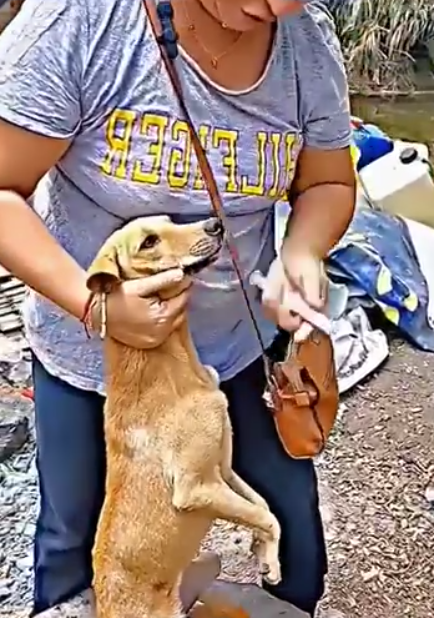
In the quiet corner of a dusty road near the edge of town, life seemed to move at a slower pace. Tall grass swayed lazily in the warm breeze, and the faint sound of birds chirping offered a sense of calm. But on this otherwise peaceful afternoon, one local woman named Sarah noticed something that shattered the calm and pierced her heart with sorrow.
There, barely visible against the dirt and dried grass, was a creature so thin, so ghost-like, it seemed to have been forgotten by the world. It was a dog—though it took Sarah a few moments to even recognize it as such. Its fur was patchy, its ribs jutted out like sharp bones through torn skin, and its eyes—sunken and dull—held a kind of silent scream for help.
Sarah gasped. “Oh my God…”
The dog didn’t react. It simply lay there, trembling slightly. Its legs were folded underneath, too weak to lift its body. Flies buzzed around its face, and there were wounds on its sides that looked infected. For a moment, Sarah froze, overwhelmed by the image in front of her.
She rushed back to her car, grabbing the sandwich she had packed for lunch. Tearing it into small pieces, she returned slowly, crouching down several feet away.
“Hey, sweetie,” she whispered softly. “It’s okay. I’m not going to hurt you.”
The dog flicked its ear but made no attempt to move. Sarah tossed a piece of sandwich gently onto the ground near its nose. After a long pause, the dog’s nose twitched. Then, slowly, with immense effort, it moved its head and began to nibble on the food.
Tears welled up in Sarah’s eyes. This animal was starving to death, and yet still clung to life.
Later that day, Sarah returned with a crate, a bowl of water, and a few cans of dog food. With great care and patience, she eventually managed to lift the dog into her car and drive it to the nearest animal shelter. On the way, she kept glancing at it in her rearview mirror, half expecting it to stop breathing.
When they arrived at the shelter, the staff was shocked. One of the vet technicians, Leo, said it was one of the worst cases of neglect he’d ever seen.
“This dog is on the brink,” he said grimly. “We’ll do everything we can, but it’s going to be a long road.”
The shelter named the dog “Hope.”
Hope was given fluids through an IV, gentle baths to clean her wounds, and a special diet to help her gain weight slowly and safely. At first, she couldn’t even stand. The shelter staff and volunteers had to hold her up to help her relieve herself. But they never gave up. They spoke to her, petted her gently, and treated her with more love than she had likely ever known.
Over the next few weeks, a transformation slowly began to take shape.

Sarah visited Hope every day. She brought her blankets, soft toys, and sat with her for hours reading aloud or simply talking to her. Bit by bit, Hope began to respond. Her eyes, once lifeless and distant, began to light up when Sarah entered the room. Her tail, once limp, gave the faintest wag one morning—just once, but it was a miracle.
Then came the biggest moment yet: Hope stood up on her own.
The entire shelter staff gathered and applauded like proud parents. Sarah knelt down with tears streaming down her cheeks. “You did it, girl,” she whispered, hugging her gently.
Hope’s recovery continued, slow but steady. Her wounds healed, her coat began to regrow, and she put on weight. Most importantly, she began to trust again. She learned to walk without falling, barked playfully at her caretakers, and even chased a ball one sunny afternoon.
But her journey was far from over.
Despite her progress, Hope had lasting scars—both physical and emotional. She flinched at sudden movements, cowered when voices were raised, and didn’t like being left alone. Sarah, recognizing that bond they had formed, decided to take the next step.
She adopted Hope.
Bringing her home wasn’t easy. Hope had never lived in a real house. The new smells, sounds, and routines made her nervous. But Sarah was patient. She never rushed her. Slowly, Hope began to settle in. She had her own soft bed, regular meals, walks in the park, and a yard where she could lay in the sun.
What once had been a heartbreaking sight—a skeletal animal clinging to life—was now a happy, wagging, healthy dog learning to love life.
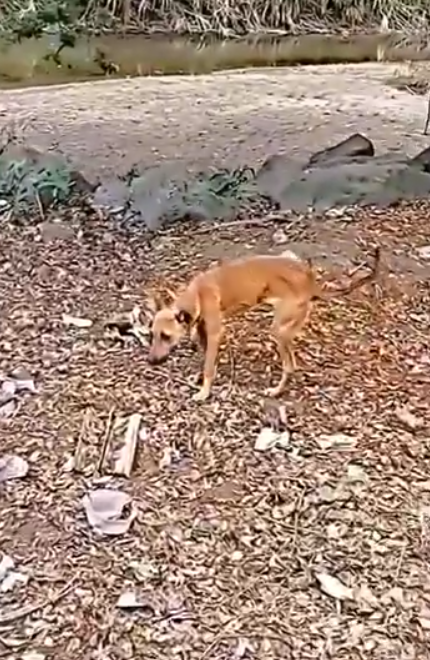
Months passed, and Hope became somewhat of a local celebrity. Sarah shared her story on social media, and thousands of people followed Hope’s recovery. Donations poured into the shelter, inspired by one dog’s will to live and the kindness of one woman who stopped to care.
The attention also helped bring awareness to animal neglect and the importance of responsible pet ownership. Hope’s story was featured in the local newspaper, and Sarah gave talks at schools and community centers about compassion for animals.
One day, as Sarah sat on the porch sipping tea, Hope lay curled at her feet, her head resting gently on Sarah’s slipper. The golden sunset cast a warm glow over them, and Sarah couldn’t help but smile.
“I think you saved me, too,” she said softly.
Hope’s story is a powerful reminder of how easily suffering can go unseen and how even the smallest act of compassion can change a life forever. She was once just a shadow in the dirt, nearly invisible to the world. But someone saw her. Someone cared.
And because of that, she not only survived—she thrived.
If you ever come across an animal in distress, don’t look away. You may be the only hope they have. And in saving them, you might just find something beautiful in yourself, too.
